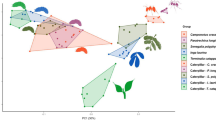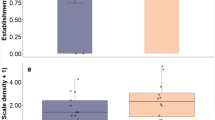Summary
Abundances of the specialist herbivore, Acalymma vittata (Fab.) (Coleoptera: Chrysomelidae), were assessed in small experimental plots with three levels of plant diversity (cucumber monoculture, cucumber/corn, and cucumber/tomato) and two levels of host plant growth form (horizontal on the ground and vertical, staked up or growing up other plant species). Host plant growth form more strongly affected beetle abundances than did plant diversity; greater numbers were found on vertically growing than on horizontally growing cucumber plants. The combination of cucumber monoculture and vertical growth form supported significantly greater herbivore abundances than did any other type of plot, emphasizing a strong interaction between diversity and growth form. Beetles were not more common in monocultures with horizontal growth forms than in mixed species plots, and beetles did not respond differently to plots with corn and plots with tomatoes.
Feeding experiments demonstrated that the plant diversity under which a host plant is grown strongly influenced herbivore feeding preference. Beetles given a choice of cucumber leaves grown in monoculture and in plots with tomatoes exhibited individual differences in their food selection behavior, however, a significantly greater number of beetles preferred monoculture leaves. Those individuals preferring monoculture leaves and those individuals preferring leaves from plots with tomatoes did not differ in either absolute or relative amounts of feeding damage per leaf.
Neither plant size nor the date on which plots were colonized by beetles explained the differences in herbivore abundance. It is suggested that differences in movement patterns and plant quality contributed to the greater numbers of beetles on plants growing vertically in monocultures.
Similar content being viewed by others
References
Altieri MA, van Schoonhoven A, Doll J (1977) The ecological role of weeds in insect pest management systems: a review illustrated by bean (Phaseolus vulgaris) cropping systems. PANS 23:195–205
Altieri MA, Francis CA, van Schoonhoven A, Doll JD (1978) A review of insect prevalence in maize (Zea mays L.) and bean (Phaseolus vulgaris L.) polycultural systems. Field Crop Res 1:33–49
Bach CE (1980a) Effects of plant diversity and time of colonization on an herbivore-plant interaction. Oecologia (Berl) 44:319–326
Bach CE (1980b) Effects of plant density and diversity on the population dynamics of a specialist herbivore, the striped cucumber beetle, Acalymma vittata (Fab.). Ecology 61:1515–1530
Bach CE, Hruska AJ (1981) Effects of plant density on the growth, reproduction and survivorship of cucumbers (Cucumis sativus L.) in monocultures and polycultures. J Appl Ecol: In Press
Brown JJ, Jermy T, Butt BA (1980) The influence of an alternate host plant on the fecundity of the colorado potato beetle, Leptinotarsa decemlineata (Coleopotera: Chrysomelidae). Ann Entomol Soc Am 73:197–199
Cates RG (1980) Feeding patterns of monophagous, oligophagous, and polyphagous insect herbivores: the effect of resource abundance and plant chemistry. Oecologia (Berl) 46:22–31
Chiang HC, Flaskard RG (1965) Sampling methods of adult populations of the corn rootworm. Proc N Cent Br Ent Soc Am 20:67–68
Chew FS (1980) Food plant preferences of Pieris caterpillars (Lepidoptera). Oecologia (Berl) 46:347–353
Cromartic WJ (1975) The effect of stand size and vegetational background on the colonization of cruciferous plants by herbivorous insects. J Appl Ecol 12:517–533
Dempster JP, Coaker TH (1974) Diversification of crop ecosystems as a means of controlling pests. In: DP Jones, ME Solomon (eds), Biology in pest and disease control. Blackwell Sci Pub London p 106–114
Fagan TW, Phillips R, Davies RO (1943) The cultivation and composition of kale. Welsh Jour Agric 17:97–101
Hsiao TH, Fraenkel G (1968) Selection and specificity of the colorado potato beetle for solanaceous and nonsolanaceous plants. Ann Entomol Soc Am 61:493–503
Lower RL (1972) Effect of surrounding cultivar when screening cucumber for resistance to cucumber beetle and pickleworm. J Amer Soc Hort Sci 97:616–618
Lawton JH (1978) Host-plant influences on insect diversity: the effect of space and time. In: LA Mound, N Waloff (eds), Diversity of insect faunas. RES Symp 9 Blackwell Sci Pub Oxford p 105–125
Mattson WJ (1980) Herbivory in relation to plant nitrogen content. Ann Rev Ecol Syst 11:119–161
McNeill S, Southwood TRE (1978) The role of nitrogen in the development of insect/plant relationships. In: JB Harborne (ed), Biochemical aspects of plant and animal coevolution. Proc Phytochem Soc 15 Academic Press New York-London p 77–98
Morrow PA, Fox LR (1980) Effects of variation in Eucalyptus essential oil yield on insect growth and grazing damage. Oecologia (Berl) 45:209–219
Murdoch WM, Evans FC, Peterson CH (1972) Diversity and pattern in plants and insects. Ecology 53:819–829
Pimentel D (1961) The influence of plant spatial patterns on insect populations. Ann Ent Soc Am 54:61–69
Ralph CP (1976) Natural food requirements of the large milkweed bug, Oncopeltus fasciatus (Hemiptera: Lygaeidae) and their relation to gregariousness and host plant morphology. Oecologia (Berl) 26:157–175
Ralph CP (1977a) Effect of host plant density on populations of a specialized seed-sucking bug, Oncopeltus fasciatus. Ecology 58:799–809
Ralph CP (1977b) Search behavior of the large milkweed bug, Oncopeltus fasciatus (Hemiptera: Lygaeidae). Ann Ent Soc Am 70:337–342
Raupp MJ, Denno RF (1979) The influence of patch size on a guild of sap-feeding insects that inhabit the salt marsh grass Spartina patens. Environ Entomol 8:412–417
Risch SJ (1979) A comparison, by sweep sampling, of the insect fauna from corn and sweet potato monocultures and dicultures in Costa Rica. Oecologia (Berl) 42:195–211
Root RB (1973) Organization of a plant-arthropod association in simple and diverse habitats: the fauna of collards (Brassica oleracea). Ecol Monographs 43:95–124
Scriber JM, Feeny P (1979) Growth of herbivorous caterpillars in relation to feeding specialization and to the growth form of their food plants. Ecology 60:829–850
Slansky F, Feeny P (1977) Stabilization of the rate of nitrogen accumulation by larvae of the cabbage butterfly on wild and cultivated food plants. Ecol Monographs 47:209–228
Smith JG (1976) Influence of crop background on aphids and other phytophagous insects on brussel sprouts. Ann Appl Biol 83:1–13
Smith RW, Whittaker JB (1980a) The influence of habitat type on the population dynamics of Gastrophysa viridula DeGeer (Coleoptera: Chrysomelidae). J Anim Ecol 49:225–236
Smith JW, Whittaker JB (1980b) Factors affecting Gastrophysa viridula populations (Coleoptera: Chrysomelidae) in different habitats. J Anim Ecol 49:537–548
Tahvanainen JO, Root RB (1972) The influence of vegetational diversity on the population ecology of a specialized herbivore, Phyllotreta cruciferae (Coleoptera: Chrysomelidae). Oecologia (Berl) 10:321–346
Thompson JN, Price PW (1977) Plant plasticity, phenology, and herbivore dispersion: wild parsnip and the parsnip webworm. Ecology 58:1112–1119
van Emden HF (1965) The effect of uncultivated land on the distribution of cabbage aphid on an adjacent crop. J Appl Ecol 2:171–196
Way MJ, Heathcote GD (1966) Interactions of crop density of field beans, abundance of Aphis fabae Scop., virus incidence and aphid control by chemicals. Ann Appl Biol 57:409–423
Winter AG (1961) New physiological and biological aspects in the interrelationships between higher plants. In: FL Milthorpe (ed), Mechanisms in biological competition, Symp Soc Exp Biol 15 Academic Press New York-London p 229–244
Author information
Authors and Affiliations
Rights and permissions
About this article
Cite this article
Bach, C.E. Host plant growth form and diversity: Effects on abundance and feeding preference of a specialist herbivore, Acalymma vittata (Coleoptera: Chrysomelidae). Oecologia 50, 370–375 (1981). https://doi.org/10.1007/BF00344978
Received:
Issue Date:
DOI: https://doi.org/10.1007/BF00344978




